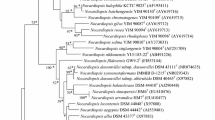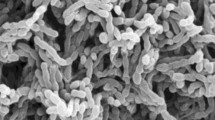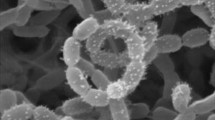Abstract
A novel actinobacterium, strain N9999T, was isolated from soil and its taxonomic position determined using a polyphasic approach. The organism formed abundant aerial hyphae that differentiated into spherical spore vesicles. The cell wall contained meso-diaminopimelic acid; the whole-cell sugars were galactose, glucose, mannose, madurose and ribose; the predominant menaquinones MK-9 (H2) and MK-9 (H4); the major phospholipids phosphatidylethanolamine, diphosphatidylglycerol, a phosphaglycolipid and phosphatidylinositol mannosides; while the cellular fatty acids were rich in iso-C14:0, C15:0, cis-9-C17:1, iso-C16:0 and 10-methyl C17:0 components. Phylogenetic analyses based on an almost complete 16S rRNA gene sequence indicated that strain N9999T was closely related to a group that consisted of Streptosporangium pseudovulgare DSM 43181T and Streptosporangium nondiastaticum DSM 43848T. However, DNA–DNA relatedness and phenotypic data demonstrated that strain N9999T was clearly distinguished from all closely related Streptosporangium species. The combined genotypic and phenotypic data demonstrate conclusively that the isolate should be classified as a new species of Streptosporangium.


Similar content being viewed by others
References
Cashion P, Holder-Franklin MA, McCully J, Franklin M (1977) A rapid method for the base ratio determination of bacterial DNA. Anal Biochem 81:461–466
Chun J, Goodfellow M (1995) A phylogenetic analysis of the genus Nocardia with 16S rRNA gene sequences. Int J Syst Bacteriol 45:240–245
Chun J, Lee J-H, Jung Y, Kim M, Kim S, Kim BK, Lim YW (2007) EzTaxon: a web-based tool for the identification of prokaryotes based on 16S ribosomal RNA gene sequences. Int J Syst Evol Microbiol 57:2259–2261
Collins MD, Pirouz T, Goodfellow M, Minnikin DE (1977) Distribution of menaquinones in actinomycetes and corynebacteria. J Gen Microbiol 100:221–230
De Ley J, Cattoir H, Reynaerts A (1970) The quantitative measurement of DNA hybridization from renaturation rates. Eur J Biochem 12:143–153
Felsenstein J (1981) Evolutionary trees from DNA sequences: a maximum likelihood approach. J Mol Evol 17:368–376
Felsenstein J (1985) Confidence limits on phylogeny: an approach using the bootstrap. Evolution 39:783–791
Fitch WM (1971) Toward defining the course of evolution: minimum change for a specific tree topology. Syst Zool 20:406–416
Gonzalez JM, Saiz-Jimenez C (2005) A simple fluorimetric method for the estimation of DNA–DNA relatedness between closely related microorganisms by thermal denaturation temperatures. Extremophiles 9:75–79
Goodfellow M, Quintana ET (2012) Family 1. Streptosporangiaceae Goodfellow, Stanton, Simpson and Minnikin 1990a 321VP. In: Goodfellow M, Kämpfer P, Busse H-J, Trujillo M, Suzuki KE, Ludwig W, Whitman WB (eds) Bergey’s manual of systematic bacteriology, 2nd edn, vol 5. Springer, New York (in press)
Goodfellow M, Alderson G, Lacey J (1979) Numerical taxonomy of Actinomadura and related actinomycetes. J Gen Microbiol 112:95–111
Gordon RE, Mihm JM (1962) Identification of Nocardia caviae. (Erikson) nov. comb. Ann N Y Acad Soc 98:628–636
Hayakawa M, Nonomura H (1987) Humic acid-vitamin agar, a new medium for the selective isolation of soil actinomycetes. J Ferment Technol 65:501–509
Hayakawa M, Tamura T, Iino H, Nonomura H (1991) New methods for the highly selective isolation of Streptosporangium and Dactylosporangium from soil. J Ferment Bioeng 72:327–333
Hsu SC, Lockwood JL (1975) Powdered chitin agar as a selective medium for enumeration of actinomycetes in water and soil. Appl Microbiol 29:422–426
Huss VAR, Festl H, Schleifer KH (1983) Studies on the spectrometric determination of DNA hybridisation from renaturation rates. Syst Appl Microbiol 4:184–192
Inahashi Y, Matsumoto A, Ōmura S, Takahashi Y (2011) Streptomyces oxazolinicum sp. nov., a novel endophytic actinomycete producing new antitrypanosomal antibiotics, spoxazomicins. J Antibiot (Tokyo) 64:297–302
Jones KL (1949) Fresh isolates of actinomycetes in which the presence of sporogenous aerial mycelia is a fluctuating characteristic. J Bacteriol 57:141–145
Jukes TH, Cantor CR (1969) Evolution of protein molecules. In: Munro HN (ed) Mammalian protein metabolism, vol. 3. Academic Press, New York, pp 21–132
Kämpfer P, Kroppenstedt RM (1996) Numerical analysis of fatty acid patterns of coryneform bacteria and related taxa. Can J Microbiol 42:989–1005
Kelly KL (1964) Inter-Society Color Council-National Bureau of standards color-name charts illustrated with centroid colors. US Government Printing Office, Washington, DC
Kroppenstedt RM, Goodfellow M (2006) The family Thermomonosporaceae: Actinocorallia, Actinomadura, Spirillispora and Thermomonospora. In: Dworkin M, Falkow S, Schleifer KH, Stackebrandt E (eds) The prokaryotes, archaea and bacteria: firmicutes, actinomycetes, 3rd edn, vol 3. , Springer, New York, pp 682–724
Larkin MA, Blackshields G, Brown NP, Chenna R, McGettigan PA, McWilliam H, Valentin F, Wallace IM, Wilm A, Lopez R, Thompson JD, Gibson TJ, Higgins DG (2007) Clustal W and Clustal X version 2.0. Bioinformatics 23:294–2947
Lazzarini A, Cavaletti L, Toppo G, Marinelli F (2000) Rare genera of actinomycetes as potential producers of new antibiotics. Antonie Van Leeuwenhoek 78:399–405
Lechevalier MP, Lechevalier HA (1970) Chemical composition as a criterion in the classification of aerobic actinomycetes. Int J Syst Bacteriol 20:435–443
Lechevalier MP, De Bievre C, Lechevalier HA (1977) Chemotaxonomy of aerobic actinomycetes: phospholipid composition. Biochem Syst Ecol 5:26–249
Minnikin DE, O’Donnell AG, Goodfellow M, Alderson G, Athalye M, Schaal A, Parlett JH (1984) An integrated procedure for the extraction of bacterial isoprenoid quinones and polar lipids. J Microbiol Methods 2:233–241
Nash P, Krent MM (1991) Culture media. In: Balows A, Hauser WJ, Herrmann KL, Isenberg HD, Shadomy HJ (eds) Manual of clinical microbiology, 5th edn. American Society for Microbiology, Washington DC, pp 1268–1270
Nonomura H, Okara Y (1960) Distribution of actinomycetes in soil. V. The isolation and classification of the genus Streptosporanium. J Ferment Technol 38:405–409
O’Donnell AG, Falconer C, Goodfellow M, Ward AC, Williams E (1993) Biosystematics and diversity amongst novel carboxydotrophic actinomycetes. Antonie Van Leeuwenhoek 64:325–340
Quintana ET, Goodfellow M (2012) Genus 1. Streptosporanium Couch 1995a, 145AL emend. Stackebrandt Kroppenstedt, Janke, Kemmering and Gűrtler 1994, 268. In: Goodfellow M, Kämpfer P, Busse MJ, Trujillo M, Suzuki KE, Ludwig W, Whitman WB (eds) Bergey’s manual of systematic bacteriology, 2nd edn, vol 5. Springer, New York (in press)
Saitou N, Nei M (1987) The neighbor-joining method. A new method for reconstructing phylogenetic trees. Mol Biol Evol 4:406–425
Sasser M (1990) Identification of bacteria by gas chromatography of cellular fatty acids. MIDI Technol Note 101. MIDI Inc., Newark
Shirling EB, Gottlieb D (1966) Methods for characterization of Streptomyces species. Int J Syst Bacteriol 16:313–340
Staneck JL, Roberts CD (1974) Simplified approach to identification of aerobic actinomycetes by thin-layer chromatography. Appl Microbiol 28:226–231
Tamura K, Peterson D, Peterson N, Stecher G, Nei M, Kumar S (2011) MEGA5: molecular evolutionary genetics analysis using maximum likelihood, evolutionary distance, and maximum parsimony methods. Mol Bio Evol 28:273–2731
Wang Y, Zhang ZS, Ruan TS, Ali SM (1999) Investigation of actinomycete diversity in the tropical rainforests of Singapore. J Ind Microbiol Biotechnol 23:178–187
Wayne LG, Brenner DJ, Colwell RR, Grimont PAD, Kandler O, Krichevsky MI, Moore LH, Moore WEC, Murray RGE (1987) International committee on systematic bacteriology. Report of the ad hoc committee on reconciliation of approaches to bacterial systematics. Int J Syst Bacteriol 37:463–464
Weyland H (1969) Actinomycetes in North Sea and Atlantic Ocean sediments. Nature 223:858
Whitham TS, Athalye M, Minnikin DE, Goodfellow M (1993) Numerical and chemical classification of Streptosporangium and some related actinomycetes. Antonie Van Leeuwenhoek 64:387–429
Williams ST, Goodfellow M, Alderson G, Wellington EMH, Sneath PHA, Sackin MJ (1983) Numerical classification of Streptomyces and related genera. J Gen Microbiol 129:1743–1813
Zhang L-P, Zhang L-M, Zhang X-M (2009) Streptosporangium canum sp. nov., isolated from soil. Int J Syst Evol Microbiol 59:1715–1719
Zhang Y-Q, Liu H-Y, Yu L-Y, Lee J-C, Park D-J, Kim C-J, Xu L-H, Jiang C-L, Li W-J (2011) Sinosporangium album gen. nov., sp. nov., a new member of the suborder Streptosporangineae. Int J Syst Evol Microbiol 61:592–597
Acknowledgments
This research was supported by Ondokuz Mayis University (OMU), project no. PYO. FEN. 1901.09.003. The authors’ thank Professor Jean Paul Marie Euzéby for his help with the nomenclature.
Author information
Authors and Affiliations
Corresponding author
Electronic supplementary material
Below is the link to the electronic supplementary material.
Rights and permissions
About this article
Cite this article
Sazak, A., Sahin, N., Camas, M. et al. Streptosporangium anatoliense sp. nov., isolated from soil in Turkey. Antonie van Leeuwenhoek 102, 269–276 (2012). https://doi.org/10.1007/s10482-012-9735-x
Received:
Accepted:
Published:
Issue Date:
DOI: https://doi.org/10.1007/s10482-012-9735-x




